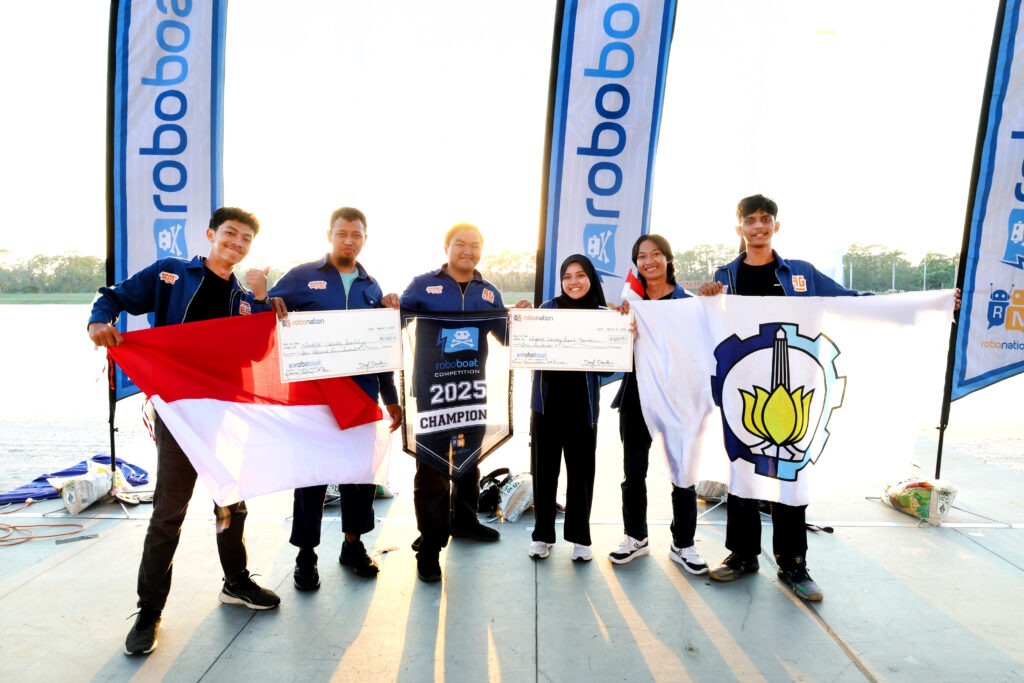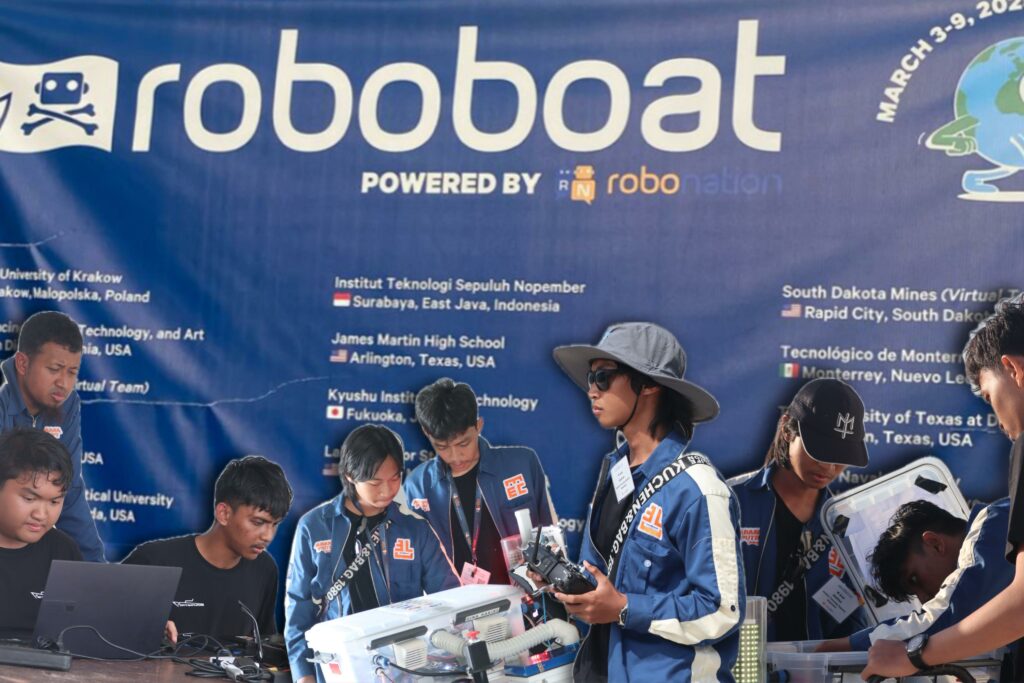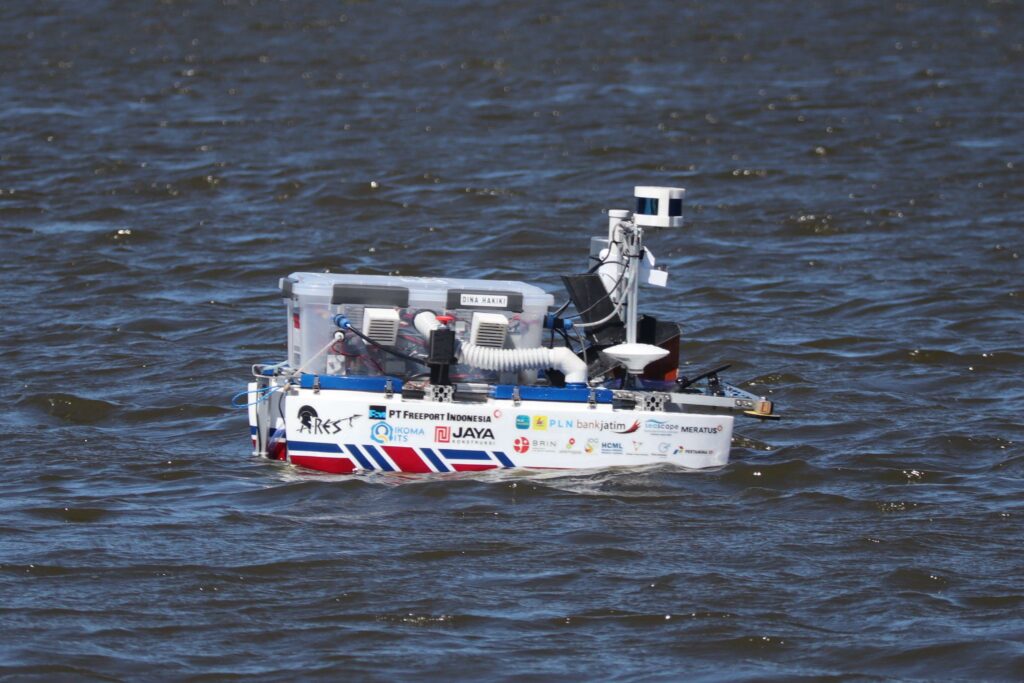Led by FT-EIC Student, Barunastra ITS Wins Grand Champion Title at IRC 2025
Faculty

Image: Taib Izzat (third from left) with the Barunastra Team celebrating their Grand Champion title.
The Barunastra Team from Institut Teknologi Sepuluh Nopember (ITS) has once again carved out an impressive achievement by bringing home the Grand Champion title at the prestigious International Roboboat Competition (IRC) 2025. The competition, held at Nathan Benderson Park, Florida, USA, featured 30 teams from various countries and is regarded as a top-tier event for maritime technology innovators. Participating teams included those from renowned institutions such as the Massachusetts Institute of Technology (MIT), the University of Michigan, Kyushu Institute of Technology, and many more.
Taib Izzat Samawi, General Manager of Barunastra ITS from the Department of Informatics Engineering, Faculty of Intelligent Electrical and Informatics Technology (FT-EIC) ITS, stated that his team secured the top spot at the International Roboboat Competition 2025 by winning 1st Place in the Autonomy Challenge, 2nd Place in Design Documentation, and once again earned the world champion title for the sixth time.
“In that category, the evaluation was based on how well the boat could autonomously navigate and complete the assigned missions,” explained Taib. This success was the result of the hard work of the team members, which included M. Andi Abdillah (Electrical Engineering), Alifa Hikmawati (Mathematics), Arundaya Pratama Nurhasan (Informatics Engineering), M. Farras Rheza Firmansyah (Naval Architecture), and other contributors involved in the development of Barunastra ITS’s autonomous boat.
This year, IRC adopted the theme “Environmental Monitoring: Guardians of the Water”. All participating teams were challenged to complete six missions: Navigation Channel, Mapping Migration Pattern, Treacherous Water, Race Against Pollution, Rescue Deliveries, and Return to Home.
Taib further elaborated on the mechanism of the Autonomy Challenge. Like other competitions, the team—mentored by Dr. Rudy Dikairono, ST., MT. (Electrical Engineering), Muhammad Lukman Hakim, ST., MT. (Industrial Mechanical Engineering), and Muhtadin, ST., MT. (Computer Engineering)—had to go through three stages: qualification, semifinal, and final.
In addition to the Autonomy Challenge, the team also competed in the Design Documentation category, which evaluated the research and technological innovation behind the boat. Barunastra ITS secured second place, demonstrating the team’s technical excellence and research capability in addressing modern maritime challenges.
In the competition, the Barunastra team introduced their latest prototype, Nala ARES. This boat features a more efficient hull design with optimized buoyancy to protect the electronic components onboard. One of Nala ARES’s notable advantages is its lighter weight compared to previous prototypes, allowing for more dynamic performance. It is also equipped with a more advanced propulsion system, enabling more precise movement. Moreover, with a single box configuration and reduced size and number of components, Nala ARES’s electrical system is significantly more efficient.
Nala ARES is operated using a simplified software architecture. The program consists of a perception module for receiving and processing information, a cognition module for decision-making and strategy planning, and a behavior module responsible for executing actions to complete the missions.
Taib also emphasized that the team’s success would not have been possible without the support of various parties, including sponsors such as PT Freeport Indonesia, PT Jaya Konstruksi Manggala Pratama Tbk, IKOMA ITS, PT Pertamina Gas Negara, PT Pertamina International Shipping, PT PLN (Persero), Bank Jatim, PT Len Rekaprima Semesta, PT Seascape Surveys Indonesia, PT Meratus Line, PT Infrastruktur Telekomunikasi Indonesia, the Hydrodynamic Laboratory of the National Research and Innovation Agency, PT Perdana Chemindo Perkasa, PT Petrokimia Gresik, PT Wijaya Karya Bangunan Gedung, PT Pelindo Marine Service, PT PLN Indonesia Power, Husky-CNOOC Madura Limited, Medco Energi Sampang, Kangean Energy Indonesia Ltd., Pertamina EP Sukowati Field, Print and Print, and PT Asian Bearindo Jaya—all of whom played a crucial role in supporting the team’s journey to the competition. Taib concluded with hope that this achievement would inspire Indonesia’s younger generation to keep innovating in technological development.
“We want to prove that Indonesia has extraordinary talent capable of competing on the international stage,” he proudly said.
Latest News
-
ELECTICS ITS Welcomes Vocational High School Interns Across Its Departments
The Faculty of Intelligent Electrical and Informatics Technology (F-ELECTICS) at Institut Teknologi Sepuluh Nopember (ITS) continues to strengthen its
-
From Hobby to Achievement: Azril Fathoni’s Journey in Conquering the World of Cyber Security
What started as curiosity and a love for solving challenges turned into a path of achievement for Muhammad Azril
-
Led by FT-EIC Student, Barunastra ITS Wins Grand Champion Title at IRC 2025
The Barunastra Team from Institut Teknologi Sepuluh Nopember (ITS) has once again carved out an impressive achievement by bringing







